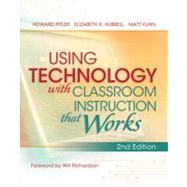Using Technology with Classroom Instruction that Works
, by Pitler, Howard; Hubbell, Elizabeth R.; Kuhn, Matt- ISBN: 9781416614302 | 1416614303
- Cover: Paperback
- Copyright: 8/7/2012
Technology is ubiquitous, and its potential to transform learning is immense. The first edition of Using Technology with Classroom Instruction That Works answered some vital questions about 21st century teaching and learning: What are the best ways to incorporate technology into the curriculum? What kinds of technology will best support particular learning tasks and objectives? How does a teacher ensure that technology use will enhance instruction rather than distract from it? This revised and updated second edition of that best-selling book provides fresh answers to these critical questions, taking into account the enormous technological advances that have occurred since the first edition was published, including the proliferation of social networks, mobile devices, and web-based multimedia tools. It also builds on the up-to-date research and instructional planning framework featured in the new edition of Classroom Instruction That Works, outlining the most appropriate technology applications and resources for all nine categories of effective instructional strategies: * Setting objectives and providing feedback * Reinforcing effort and providing recognition * Cooperative learning * Cues, questions, and advance organizers * Nonlinguistic representation * Summarizing and note taking * Assigning homework and providing practice * Identifying similarities and differences * Generating and testing hypotheses Each strategy-focused chapter features examples¿across grade levels and subject areas, and drawn from real-life lesson plans and projects¿of teachers integrating relevant technology in the classroom in ways that are engaging and inspiring to students. The authors also recommend dozens of word processing applications, spreadsheet generators, educational games, data collection tools, and online resources that can help make lessons more fun, more challenging, and¿most of all¿more effective.







